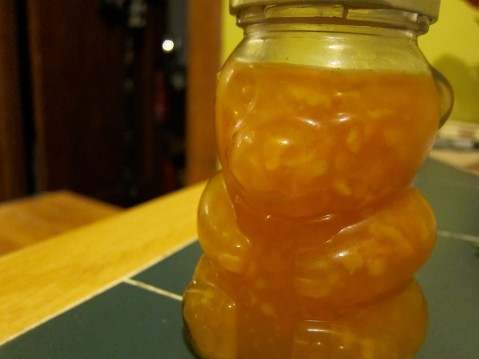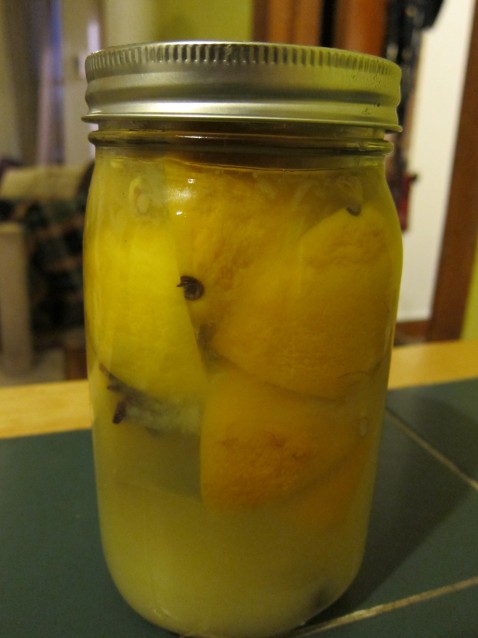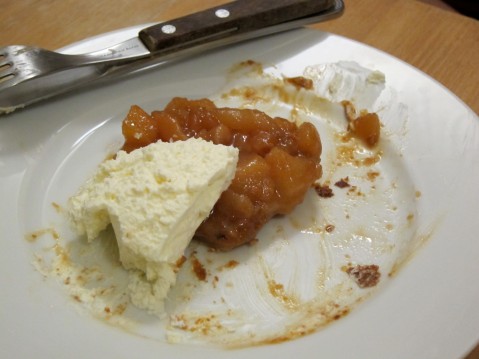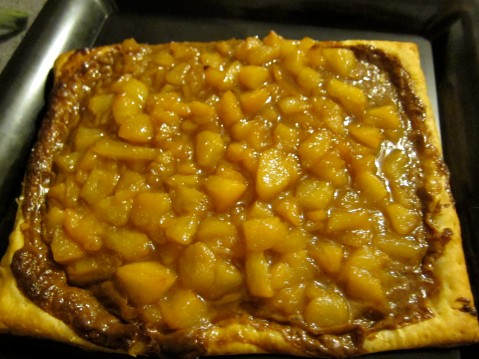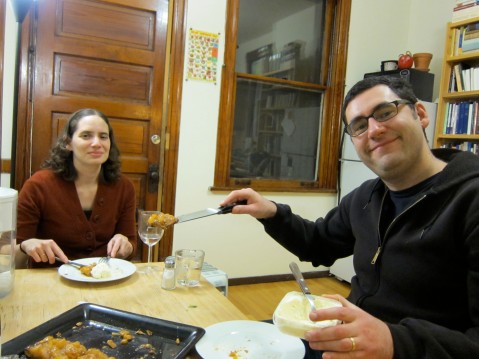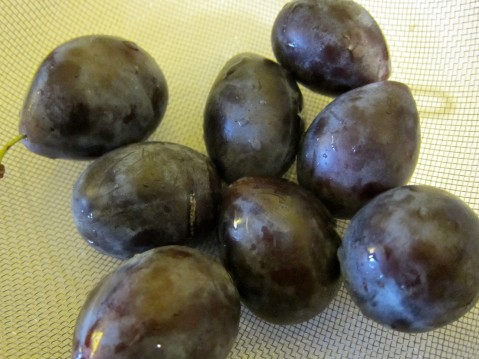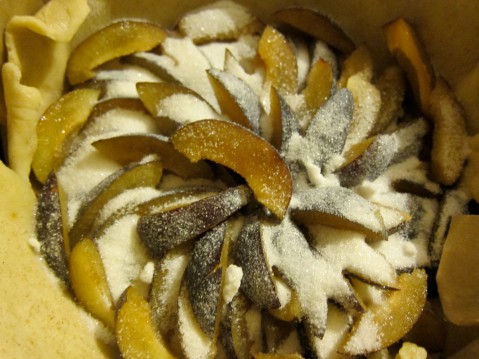Orange Marmalade
Sunshine, my best friend, you’re back! Peggy Lee says it best:
Thanks to Kelly & our conversation at dinner the other night, I’m completely in a Peggy Lee mood today. She is so fantastic. Sassy, sultry, sardonic. Funny. Billie Holiday (whom I also adore), can sing the same song (like “My Man,” for instance), and it wrenches your guts with sadness. When Peggy Lee sings it, you feel like she’s the one getting the last laugh. And today, I’m in the mood for Peggy’s version of the story. Peggy Lee reminds me of LA a little bit, perhaps they share the same sensibility–that sort of midcentury ebullience. She could fit easily in a Raymond Chandler novel, sauntering in the detective’s office with a wild tale about a missing lover. How can I not miss LA on a sunny day like this with this soundtrack? Especially when thinking about orange marmalade, when so much of the city was once covered in orange groves?
I’m going out to enjoy the sunshine. And you should too. So maybe make the Orange Marmalade manana.
Orange Marmalade
6 oranges
2 1/2 c. water
1/8 tsp. baking soda
5 1/2 c. sugar
1 package of pectin
Wash your jars and their lids.
Bring a tea kettle of water to a boil.
Bring a large pot, half-full with water, to a simmer. Add the clean jars, and pour the water from the tea kettle over them and turn off the heat. Let them sit in the hot water until you’re ready to use them (drain before using them).
Remove the colored part of the oranges with a vegetable peeler and chop finely. I used a food processor to get them pretty fine. Cut off the white part (this is bitter), and then chop the fruit itself into fine chunks, and reserve the fruit.
Place peels, water, and baking soda in a large saucepan. Bring to a boil. Reduce heat; cover and simmer for 20 minutes, stirring occasionally. Add fruit and juice, simmer 10 minutes.
Add the pectin to the saucepan. Bring mixture to a full rolling boil on high heat. The pectin box describes this as a boil that doesn’t stop bubbling when you stir it.
Add the sugar and return to a full rolling boil. Boil for exactly one minute, stirring constantly. Remove from heat, and skim off any foam.
Ladle quickly into the prepared jars, leaving about 1/8-inch space at the top. Wipe jar rims and cover with lids. Screw bands tightly and place bars back in the large pot full of water. Make sure the water covers jars by an inch or two. Cover and bring back to a boil for 10 minutes. Remove and place upright on a towel to cool. Once they’ve cooled, check seals by pressing middle of lid with finger. If lid springs back, lid is not sealed and refrigeration is necessary.
Let stand at room temperature for at least 24 hours.
You can store the jam for about a year in the cupboard, or, once opened, about 3 weeks in the fridge.
Preserved Lemons
Good morning Saturday, good morning coffee, good morning sunshine. We’ve had our first thaw and the dunes of snow have melted away, leaving little islands of dirty ice here and there in seas of dead grass. The snow was prettier, but I’m happy for the sunshine, the vitamin D, the seratonin. I have a bit of a dull head today from yesterday’s poker night, in which I lost my shirt (not literally–not that kind of poker), but did so with some aplomb for a beginner, according to Dustin.
Chalcy made me dinner last night, and I met her friends Dominique and Sandrine, who were traveling from Normandy to do various WWOOFing projects throughout the Midwest. It’s a program I’ve been hearing more about lately (though it’s been around since the seventies)–a worldwide network in which labor is exchanged on small, organic farms for food, lodging, and education about sustainable farming. It sounds wonderful: cultural exchange around food and growing practices; meeting people with the only common denominator being work and food. It seems to reflect a greater cultural romanticism in America–the idea of earthiness and labor as the exotic in a foreign exchange (unlike the yearning for ancient cosmopolitan cities when I was an exchange student). Anyways, they seemed to be having a great time. They were lovely people, and gracious about the six ill-pronounced words I know in French.
I was going to post my mushroom-pea risotto today (as Dominique and Sandrine seemed especially excited when I told them I liked to make it), which is another recipe that benefits greatly from the preserved lemons Rachel bestowed upon me in December. But I realized I should first go ahead and give you the recipe to these delicious puppies outright. Perhaps you might want to make them yourselves instead of substituting regular lemon all the time.
Don’t get me wrong, a regular lemon is a fine thing in and of itself. Sometimes, it just takes a squeeze to bring out flavors you never thought possible in a dish. But these are lemons on steroids. The Ahhnold of lemons. The northern African practice of preserving them in brine and spices brings out the citrusy oils until they buzz. They are salty, so, depending on the recipe, you may want to rinse them off or adjust your use of salt considerably.
Preserved Lemons
from Mark Bittman‘s How to Cook Everything Vegetarian
Makes about 1 quart
1 cup Kosher salt
3 pounds lemons, washed, dried, then halved
1 cinnamon stick
2 or 3 cloves
1 pinch of saffron
4 or 5 black peppercorns
1 bay leaf
2 to 3 cardamon pods
Sterilize a 1-quart canning jar and sprinkle a ¼-inch-deep layer of Kosher salt on the bottom. Place ¼ of the lemons in the bottom, sprinkling with more salt. Repeat this process, adding the spices along the way. When the jar is about ¾ full, squeeze the remaining lemons into the jar, seeds and all, so the fruit is completely submerged in the lemon and salt brine. If the juice doesn’t cover the lemons, add more lemon juice. Cover the jar with the sterilized cap.
Leave the jar out on a counter for 7-10 days, shaking it once a day during the curing time (you’ll notice interesting chemical things going on during that time, as the mixture bubbles and the spices swell up).
Move the jar into the refrigerator for the next week to continue curing the lemons before you use them. When they have finished curing, remove the lid and smell. They should smell sweet with a citrusy aroma – if you smell ammonia, the lemons are no good and should not be used (this means that air got in during the process or your jar wasn’t sterile).
If you are using the lemons in a stew or a tagine, you can blanch them in boiling water for 10 seconds to remove a little of the heavy saltiness. For salads or other quickly cooked dishes, remove the flesh and blanch the peel in boiling water, then add to dishes.
Pear and Dulce de Leche Tart
Good morning, and a good new year to you. I’ve eaten my lucky new-year black-eyed peas (thanks, Garen), and I am feeling optimistic for the year of lucky number 11. I was listening to this song this morning, and have declared it the perrrrrrrrfect anthem to start the year:
After such a sucky 2010, I think most all of us could use a little luck. Or at least a little feeling good. What better thing to eat in a lucky new year than a luscious pear and dulce de leche tart? New year diet? Bah! It has fruit, so it’s not all that bad for you. And besides, I’m a believer in eating well enough all year and not cramming it in to some guilt-packed resolution. Diet be damned. Eat some of this.
To start the year with a little inspiration, I’m reading Julia Child’s My Life in France (thanks, Melissa), and I love, love, love her exuberance. I know she had a memorable, infectious personality in real life, and it comes forth completely on the page. Here’s to a new year with even a fraction of her vigor.
I made this tart to accompany a borscht dinner by Josh and Rachel back in December. I almost went with chocolate ganache instead of dulce de leche, but I saw the can in the supermarket and I couldn’t resist. Is there anything better? Sweet, sweet, creamy goodness. I whipped up some heavy cream with sugar and vanilla for a delicious topping. It’s easy to make and, really, what doesn’t taste good on top of puff pastry?
I’m in the mood to feed people, so come on over.
Pear and Dulce de Leche Tart
6 to 7 pears, peeled and chopped into 1/4″ chunks
juice and zest of 1 lemon
2 to 3 c. apple cider
2 tsp. ground ginger
2 cinnamon sticks
1 sheet of puff pastry
3 to 4 tbsp. dulce de leche
Preheat oven to 350 degrees. Bring puff pastry out of the freezer to thaw, about 10 minutes.
In a pan over medium heat, combine pears, lemon juice & zest, cider, ginger, and cinnamon. Reduce until it becomes a thick compote. Set aside.
Spread dulce de leche in a nice, thick layer on the puff pastry. Spread the pear compote on top of that. Bake for about 20 minutes, until the pastry is brown and toasty and cooked through.
Plum Galette
It feels like fall. Cooler temperatures, lower humidity, the frequent presence of breezes. Today it rained all morning, but a cool rain. Not the humid tempestuous storms of summer. And everything seems quieter. On summer nights, the streets in my neighborhood are alive with shouts and conversations and people walking home from bars. This seems to be fading away into a more serious season. A realignment before winter.
It’s interesting to me how much my thoughts about food connect with the weather. They’re inextricable. What I’m eating inside in my kitchen is somehow linked to how the outside world makes me feel. Part of it, of course, is the availability of seasonal produce at the markets. That largely dictates what I make. But it’s also a mood. Tonight I wanted comfort so I made pasta from fresh plum tomatoes. Just garlic, tomatoes, tomato paste, and basil, plus salt, pepper, and crushed red pepper. It turns a bit colder and I want tomato sauce and carbs.
I also want to put things in pie crusts. In the last week alone, I’ve made a plum galette, a mushroom galette, and a tomato tarte tatin. It’s fall, we’re getting serious, we need baked butter. Or, I do. And the galette is the perfect pie shape, in my opinion. I love the free form, forgiving nature of it. Throw the filling in, wrap the sides over it, and throw it in the oven. It may look like there are a lot of steps to this recipe, but the pate brisee recipe is the easiest thing you’ll ever make. And really, the tart is only a matter of toasting the hazelnuts and cutting the plums. If you get ambitious, you can also make the plum jam, but luckily, I had Matt’s homemade jam in my fridge.
The plums lately have been amazing. Delicious. Gorgeous. Make this before they leave the market and we’re eating cabbage all winter. Make this before things get too serious.
Plum Galette
from Martha Stewart Living Annual Recipes 2003
1 tbsp. all-purpose flour, plus more for work surface
Pate Brisee (recipe to follow)
1/2 c. finely ground toasted hazelnuts
2 tbsp. light brown sugar
1 tbsp. cornstarch
1/4 tbsp. salt
1 & 1/2 lbs. ripe plums, sliced into 1/2-inch-thick wedges
3 tbsp. granulated sugar
1 large egg, lightly beaten
1/2 c. plum jam (recipe to follow if you want to make your own)
Preheat oven to 425 degrees with rack in lower third. On a lightly floured work surface, roll out pate brissee to 1/8 inch thick, in a roughly circular form. Transfer to a parchment-lined springform pan. You really have a choice here. You could make a rectangular galette on a baking sheet if you so desired.
In a bowl, combine flour, hazelnuts, brown sugar, conrstarch, and salt. Spread to cover the middle of the dough, leaving a 3-inch border all around.
Arrange plums in a circular fashion so that they undulate out from the center. Again, you can alter per shape and look desired. Sprinkle plums with granulated sugar. Fold dough to enclose edges; brush dough with egg wash. Chill 30 minutes in refirigerator.
Bake 10 minutes. Reduce oven heat to 400 degrees. Bake until pastry is golden brown and plums are softened, about 30 minutes. Before serving, heat jam in a saucepan over low heat, stirring until melted. Let cool a few minutes, then brush evenly over fruit.
Pate Brisee
from Martha Stewart Living Annual Recipes 2003
2 1/2 c. all-purpose flour
1 tsp. salt
8 oz. chilled unsalted butter, cut into small pieces
1/2 c. ice water
In the bowl of a food processor fitted with the metal blade, pulse flour and salt. Add butter; pulse until mixture resembles coarse meal, about 15 seconds. With machine running, add water in a slow, steady stream; process until dough just holds together. Turn out onto a piece of plastic wrap and flatten into a disk. Wrap well and chill at least 1 hour in refrigerator.
This dough recipe was enough for two tarts for me.
Matt’s Plum Jam
from the brain of Matt Wheeland
3 lbs. firm plums, cut in half and pitted
1/2 cup water
1 tablespoon lemon juice
7-1/2 cups sugar
1 (3-ounce) package commercial pectin
Preparation:
Place plums, water, and lemon juice in a large stockpot. Bring to a boil while stirring often. Reduce heat to low, cover and simmer for 10 minutes, stirring occasionally, until the fruit is soft. You should have 4 to 5 cups of fruit at the end, and you can base your pectin and sugar needs on that.
Stir in the sugar. Return heat to high and bring back to a rolling boil while constantly stirring. Add pectin and return to a boil while stirring. Continue to stir and boil for 1 minute, then remove from heat. Let sit for 1 minute, then skim off any foam.
Pour even amounts into sterilized jars, leaving 1/8-inch of space at the top. Wipe rims and seal with sterilized lids. Process in boiling water for 5 minutes.
Guest Blogger: Siggy’s Chocolate-Covered Strawberries
I imagine you’ve all been salivating over the beautiful berries at the market lately. Siggy has a simple method to create the classic chocolate-covered summer decadence. What, really, is better than ripe, fresh strawberries bathed in dark chocolate? The chocolate firms just enough to create a contrasting texture to the tender berries so that each bite is a creamy balance of sweet and bittersweet. It’s so simple, but one of my favorite things that Siggy makes. (Hint, hint: Siggy, make these soon!)
Chocolate-Covered Strawberries
Wash strawberries and dry them
Put good baking chocolate in a heat resistant bowl on top of a pot of boiling water (if you don’t own a double boiler).
Stir chocolate with wooden spoon as it melts.
Once melted, turn off heat and dip/twirl strawberries in chocolate to cover them as desired.
Lay out on parchment paper.
Wait at least half an hour to an hour for chocolate to set.
Pomegranate Risotto Pudding
I spent quite some time today trying to figure out what to do with this pomegranate. My assistant gave it to me as a valentine, and I realized I’d never actually cooked with one before. I’d never actually been presented with one before. In tact, it is lovely–a blushing, fleshy bulb. When split apart, it’s downright gorgeous. Caverns bursting with fuchsia.
In Greek myth, Persephone is courted by Hades and brought into the Underworld against her will. The law of the Underworld states that anyone who consumes food or drink while there is doomed to spend eternity there. Hades tricks Persephone into eating six pomegranate seeds. And, after Zeus pleads to have her released, Persephone must agree to revisit the Underworld for six months each year, to atone for eating the sweet seeds.
The edible part of the pomegranate being a seed, Persephone is freed from the full brunt of the punishment. She’s obligated, but not entirely. The pomegranate is a perplexing object to me. It defies the logic of fruit. Seeds should be easily accessible so as to be spread widely. What good are they underneath so much armor? Why don’t they mean eternal damnation for Persephone?
It’s an appropriate valentine, anyway. The name derives from pomum–apple–and granatus–seed, in Latin, and some Jewish scholars believe it was a pomegranate in the Garden of Eden. It has been considered an aphrodisiac in the East, with a tradition of using the seeds at wedding ceremonies as rice is used in the West. And it makes a lovely pink pudding.
Pomegranate Risotto Pudding
juice of 1 pomegranate
2 c. heavy cream
2 c. milk
1/2 tsp. vanilla extract
1/4 tsp. nutmeg
1/2 tsp. cinnamon
1 c. water
1 c. Arborio rice
1/2 tsp. salt
1/2 c. sugar
1 bay leaf
zest of one lemon, in large strips for easy removal
To juice a pomegranate, I did the following (there may be a better way of doing this, but like I said, I’m winging it): Cut the pomegranate in half. Squeeze out the seeds. Dig out the white flesh from the bowl so that it is just seeds. In a food processor, gently pulse the seeds until they are juicy, then strain the juice through a sieve, squeezing out any remaining juice. Discard seeds and set juice aside.
In a saucepan over medium heat, bring the cream, milk, vanilla, nutmeg and cinnamon to a simmer.
Meanwhile, bring 1 c. water to a boil. Stir in rice and turn the heat to medium. Keep stirring until the water is incorporated. Add sugar, salt, and a ladle full of the warm milk. Add the bay leaf and lemon zest. Stir until the milk is incorporated. Continue to add milk, ladle by ladle, stirring and incorporating until the rice soaks up the liquid. Three-quarters of the way through, add the pomegranate juice, then the rest of the milk. Let it simmer until it is a custardy consistency. The whole operation takes 30-40 minutes.
Remove the bay leaf and the lemon zest. Allow to cool in the fridge. Serve cool or room temperature with sliced almonds.

